In Formation 1/144 Boeing 717 Resin Kit with DRAW Decals Hawaiian Air Livery By Tim Bradley |  | History Originally launched in October 1995, the airplane was designated the Boeing 717 after the merger of McDonnell Douglas and The Boeing Company in 1997. Launch customer 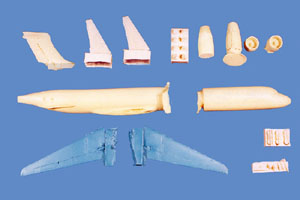 AirTran Airways took delivery of the first 717-200 on Sept. 23, 1999. There are currently 10 customers/operators of the 717 worldwide, with more than 60 airplanes in regular passenger service. With a wingspan of 93.3 feet (28.4 meters) and overall length of 124 feet (37.8 meters), the 717 is similar in size to the successful DC-9-30. AirTran Airways took delivery of the first 717-200 on Sept. 23, 1999. There are currently 10 customers/operators of the 717 worldwide, with more than 60 airplanes in regular passenger service. With a wingspan of 93.3 feet (28.4 meters) and overall length of 124 feet (37.8 meters), the 717 is similar in size to the successful DC-9-30. The Kit Being an avid airline modeler who is a self proclaimed DC- "Nine-o-holic" the MD-95 or Boeing 717 as it is now known, has been on my "want list" for six years. This variant of the DC-9 will now fill another parking spot on this modeler’s ramp. The kit was announced on DRAW Decals web site October 7th together with the new Hawaiian Air 717 decal sheet. 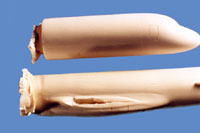 The model comes as a "complete kit" but does not come with landing gear. The landing gear has to be provided from another DC-9 or MD-80 kit. The kit is shipped in five ziplock bags containing 26 resin parts of mixed colors on the standard molding blocks. The one page instruction sheet is a quick briefing of basic assembly facts. My first impression of the kit was disappointing. The model comes as a "complete kit" but does not come with landing gear. The landing gear has to be provided from another DC-9 or MD-80 kit. The kit is shipped in five ziplock bags containing 26 resin parts of mixed colors on the standard molding blocks. The one page instruction sheet is a quick briefing of basic assembly facts. My first impression of the kit was disappointing.
Fuselage 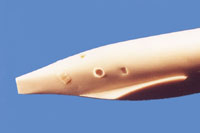 The solid resin fuselage is molded in two pieces being split vertically at the leading edge of the wing. While there is an obvious cut line for the nose section, the rear is questionable. The original mold was made from the Minicraft MD-80 kit. There are some panel lines, cabin/baggage doors and cockpit window frames retained in the front section; the rear is devoid of any, including the pronounced floor seam. What is, on the rear piece are raised pre-cooler grills, APU exhaust and A/C vents – items that were left off of the Minicraft kit. The tail is in a three-piece assembly. The horizontal stabilizers are a direct copy of the MD-80's, while the vertical stabilizer has rudder hinges engraved. The solid resin fuselage is molded in two pieces being split vertically at the leading edge of the wing. While there is an obvious cut line for the nose section, the rear is questionable. The original mold was made from the Minicraft MD-80 kit. There are some panel lines, cabin/baggage doors and cockpit window frames retained in the front section; the rear is devoid of any, including the pronounced floor seam. What is, on the rear piece are raised pre-cooler grills, APU exhaust and A/C vents – items that were left off of the Minicraft kit. The tail is in a three-piece assembly. The horizontal stabilizers are a direct copy of the MD-80's, while the vertical stabilizer has rudder hinges engraved.
Wings 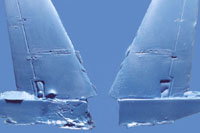 The wings are the biggest disappointment and will require the most clean-up work. In Formation used a pair of used Airfix DC-9 wings as the master. The bottom of the wings shows where the three flap hinges and the stall fence were broken off. The mounting areas were not even sanded clean. The leading and trailing edges have a lot of flash and molding debris. The wings are the biggest disappointment and will require the most clean-up work. In Formation used a pair of used Airfix DC-9 wings as the master. The bottom of the wings shows where the three flap hinges and the stall fence were broken off. The mounting areas were not even sanded clean. The leading and trailing edges have a lot of flash and molding debris.
The wing-mounting root is the next problem area. When making a cast of a part, modeling clay is sometimes used to extend the "pouring" part for the resin to have a path to the part. The clay extends over the flap on the bottom of the right wing with globs on the top. The left wing is better, but the top surface has a fillet running the entire length of the top root. All of this makes finding the correct cutting location very difficult. The wings will have to be butt jointed to the fuselage, as the male mounting tab is not molded on. The kit instruction suggests to drill and install wire supports. Included also with the wings are the new 717 "speed fairings" on the flap hinges. Engines 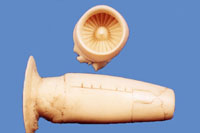 Here's the saving grace of the kit. The engines are two pieces with the intake lip and fan being the front piece and the nacelle being the rear. The intake fan rivals samples of Braz engines I've seen. The rear has a detailed hot section with fan. The internal sound suppressor will need some light clean up. The front and rear piece will require some profiling, as they don't match each other. The mounting area of the rear engine is round, while the inlet rear matting area is a rounded rectangle tapering to a round intake lip. A little sanding and putty will take care of this and turn out some fine looking engines. The surface also has scribed lines for the reverser clamshells and panels. The engine pylons are molded on the fuselage so the engines can be painted and detailed separately and glued on later. Here's the saving grace of the kit. The engines are two pieces with the intake lip and fan being the front piece and the nacelle being the rear. The intake fan rivals samples of Braz engines I've seen. The rear has a detailed hot section with fan. The internal sound suppressor will need some light clean up. The front and rear piece will require some profiling, as they don't match each other. The mounting area of the rear engine is round, while the inlet rear matting area is a rounded rectangle tapering to a round intake lip. A little sanding and putty will take care of this and turn out some fine looking engines. The surface also has scribed lines for the reverser clamshells and panels. The engine pylons are molded on the fuselage so the engines can be painted and detailed separately and glued on later.
Decals 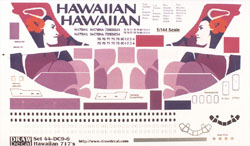 DRAW Decals comes through again with another ALPS printed "gotta have" decal. The Hawaiian Air sheet #44-DC9-6 was designed around the In Formation 717 but is not packaged in the kit. The sheet includes all tail, aft body and engine nacelle design pieces. These are done in four decals with the body section being cut in half. Greg Drawbaugh, the owner of DRAW Decals, quotes on the color instruction sheet saying " OK, this will work, I promise" and with a little patience, it looks pretty straight forward. He also helps the modeler by numbering the sections in order of application. The sheet includes all doors, windows, silver frames, and overwing exits and paths. There are two complete N numbers and extra single numbers to do all thirteen ships with names referenced on the sheet. Nine extra color panels are included covering all the different shades on this colorful sheet. With well thought out instructions, sharp printing, and a stunning design, this has to be one of DRAW's finest sheets. Hawaiian is now flying new B-767's this month and hopefully we will see this sheet in the near future from DRAW. DRAW Decals comes through again with another ALPS printed "gotta have" decal. The Hawaiian Air sheet #44-DC9-6 was designed around the In Formation 717 but is not packaged in the kit. The sheet includes all tail, aft body and engine nacelle design pieces. These are done in four decals with the body section being cut in half. Greg Drawbaugh, the owner of DRAW Decals, quotes on the color instruction sheet saying " OK, this will work, I promise" and with a little patience, it looks pretty straight forward. He also helps the modeler by numbering the sections in order of application. The sheet includes all doors, windows, silver frames, and overwing exits and paths. There are two complete N numbers and extra single numbers to do all thirteen ships with names referenced on the sheet. Nine extra color panels are included covering all the different shades on this colorful sheet. With well thought out instructions, sharp printing, and a stunning design, this has to be one of DRAW's finest sheets. Hawaiian is now flying new B-767's this month and hopefully we will see this sheet in the near future from DRAW.
Conclusion The bottom line on this kit is that it will require a lot of clean up work to produce a good-looking model. I would have liked to see a better attention to detail in the master parts. You need to weigh the price and the convenience of this resin kit versus making your own 717. Here's the recipe: mix together one Airfix DC-9 kit for the wings and one Minicraft MD-80 kit for its body, landing gear and horizontal stabilizers. A Braz resin MD-87 tail and rudder and then scratch build a pair of engines. While kit bashing would cost more, it would present a sharper surface detailed model. I believe that the In Formation kit is the better deal for the price. Where can you buy the In Formation Boeing 717 kit? Photos and the mailing address are located on DRAW Decals web site at www.drawdecal.com. | 

 



|
